Artificial Intelligence (AI) is making waves across industries, but perhaps one of the most intriguing and controversial transformations is happening in the creative sector. From graphic design to music composition, writing, and filmmaking, AI is not only accelerating production—it’s redefining what it means to be creative.
In this article, we’ll explore how AI is impacting the creative industry, what opportunities it opens up, and the critical questions it raises about originality, authorship, and the future of creativity.
What Is Creative AI?
Creative AI refers to the use of artificial intelligence tools and algorithms to assist or automate tasks traditionally associated with human creativity. It includes:
- Generative AI: Creates new content like images, music, or text
- AI in design: Suggests layouts, color palettes, or visual elements
- AI in storytelling: Writes scripts, plots, or ad copy
- AI in music: Composes, mixes, or remixes audio tracks
Tools like DALL·E, Midjourney, Runway, ChatGPT, Adobe Firefly, and Jasper are becoming staples in the creative toolkit.
How AI Is Changing the Creative Process
1. Speeding Up Production
AI can automate time-consuming tasks, like background removal, video editing, or script generation—freeing up creators to focus on high-level direction and innovation.
Example:
AI tools can generate a video storyboard from a script in minutes, allowing producers to pitch ideas faster.
2. Democratizing Access to Creativity
You no longer need advanced technical skills to create compelling visuals, animations, or soundtracks. AI enables:
- Non-designers to produce professional-quality graphics
- Writers to overcome blocks with AI-generated prompts
- Musicians to remix and experiment with sounds easily
Result: More people can express themselves creatively.
3. Enhancing Creative Collaboration
AI tools serve as idea partners—suggesting variations, alternatives, or enhancements to human input.
Example:
Designers use AI to generate 100 logo variations based on one concept.
4. Data-Driven Personalization
AI helps tailor content for specific audiences or platforms—adapting tone, format, or timing to maximize impact.
Use Case:
Marketers create multiple ad variants automatically based on demographics and engagement data.
5. Augmenting Traditional Art Forms
Artists are using AI as a medium, collaborating with algorithms to create hybrid, often unpredictable works.
Example:
Refik Anadol uses AI to generate large-scale visual art installations from real-time data streams.
Areas of Impact Across Creative Fields
Graphic Design
- AI tools suggest layouts, fonts, and color schemes
- Auto-resize visuals for multiple platforms
- Generate illustrations from text prompts
Writing and Content Creation
- Generate headlines, social posts, product descriptions
- Rewrite and improve drafts
- Ideate stories or blog outlines
Video and Animation
- AI generates avatars, motion graphics, and entire video scenes
- Tools like Pictory and Runway allow editing via text prompts
Music and Sound Design
- Compose original music based on mood or genre
- AI-assisted mastering and mixing
- Vocal synthesis and harmonization
Advertising and Branding
- A/B test dozens of content variations
- Personalize visuals and messaging at scale
- Analyze performance with AI-powered insights
The Benefits of AI in the Creative Industry
- Productivity: Complete tasks faster with fewer resources
- Exploration: Instantly test multiple ideas and styles
- Consistency: Maintain brand tone and quality across formats
- Scalability: Create content for many platforms simultaneously
- Affordability: Reduce reliance on expensive agencies or freelancers
Ethical Concerns and Debates
1. Originality and Authorship
Who owns AI-generated content? Can AI-generated work be considered truly “creative”?
2. Job Displacement
While AI enhances creativity, it may also reduce demand for certain creative roles—especially entry-level design or copywriting.
3. Copyright and Fair Use
Many AI models are trained on existing works—sometimes without consent—raising legal and ethical questions.
4. Bias and Representation
If trained on biased data, AI may replicate stereotypes or exclude diverse perspectives.
5. Transparency
Audiences may not always know if content is AI-generated, blurring the lines of authenticity.
How Creators Can Adapt
- Use AI as a tool, not a replacement: Let AI handle the mechanics so you can focus on strategy and expression.
- Stay informed about copyright and licensing
- Embrace hybrid workflows: Combine manual and AI-generated work
- Highlight your human touch: Authenticity and emotion still matter deeply
The Future of Creativity with AI
- Co-creation will become the norm, with AI and humans producing art together
- Real-time generative content will personalize media experiences per user
- Interactive storytelling will allow users to shape narratives dynamically
- Creative education will shift to include AI literacy alongside traditional skills
Final Thoughts: Creativity, Reimagined
AI is not the end of human creativity—it’s a catalyst for new forms of expression. It empowers artists, lowers barriers, and inspires innovation. But it also demands responsibility, reflection, and a redefinition of what it means to create.
For creatives who embrace the possibilities and navigate the challenges, AI offers an exciting new frontier—one where imagination and machine intelligence work side by side.
